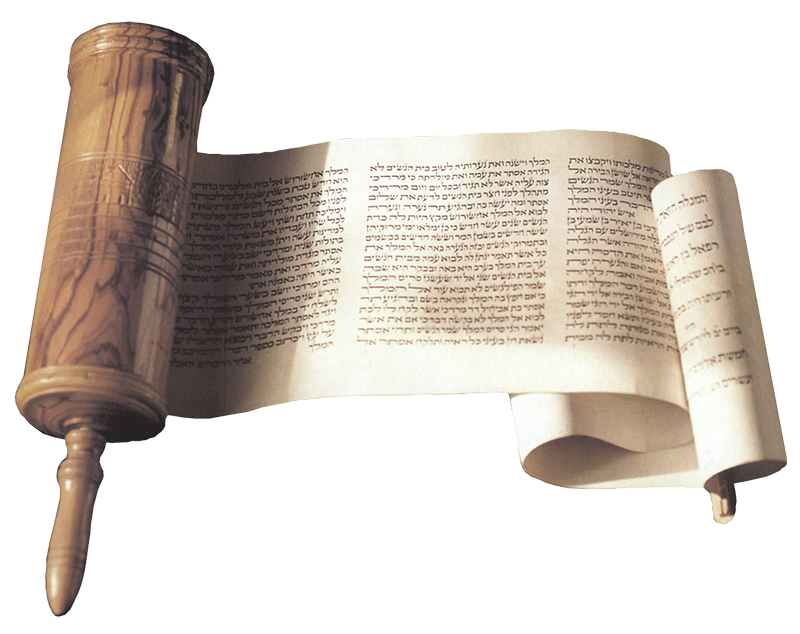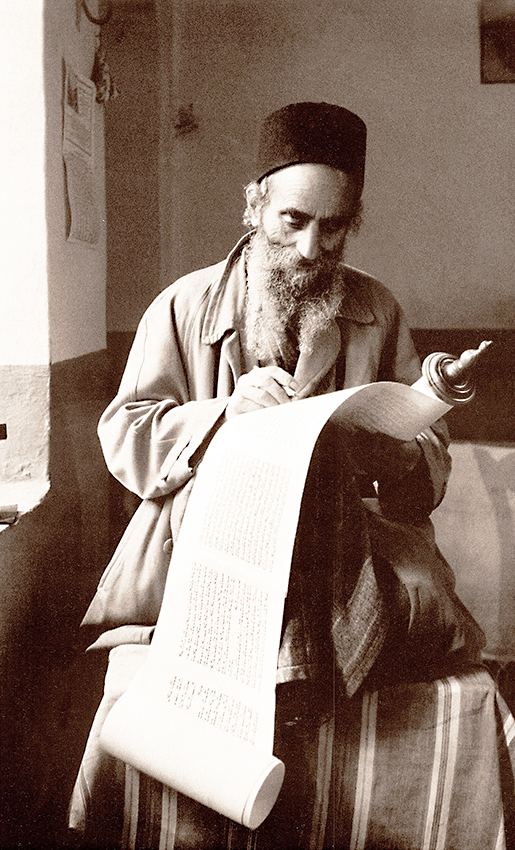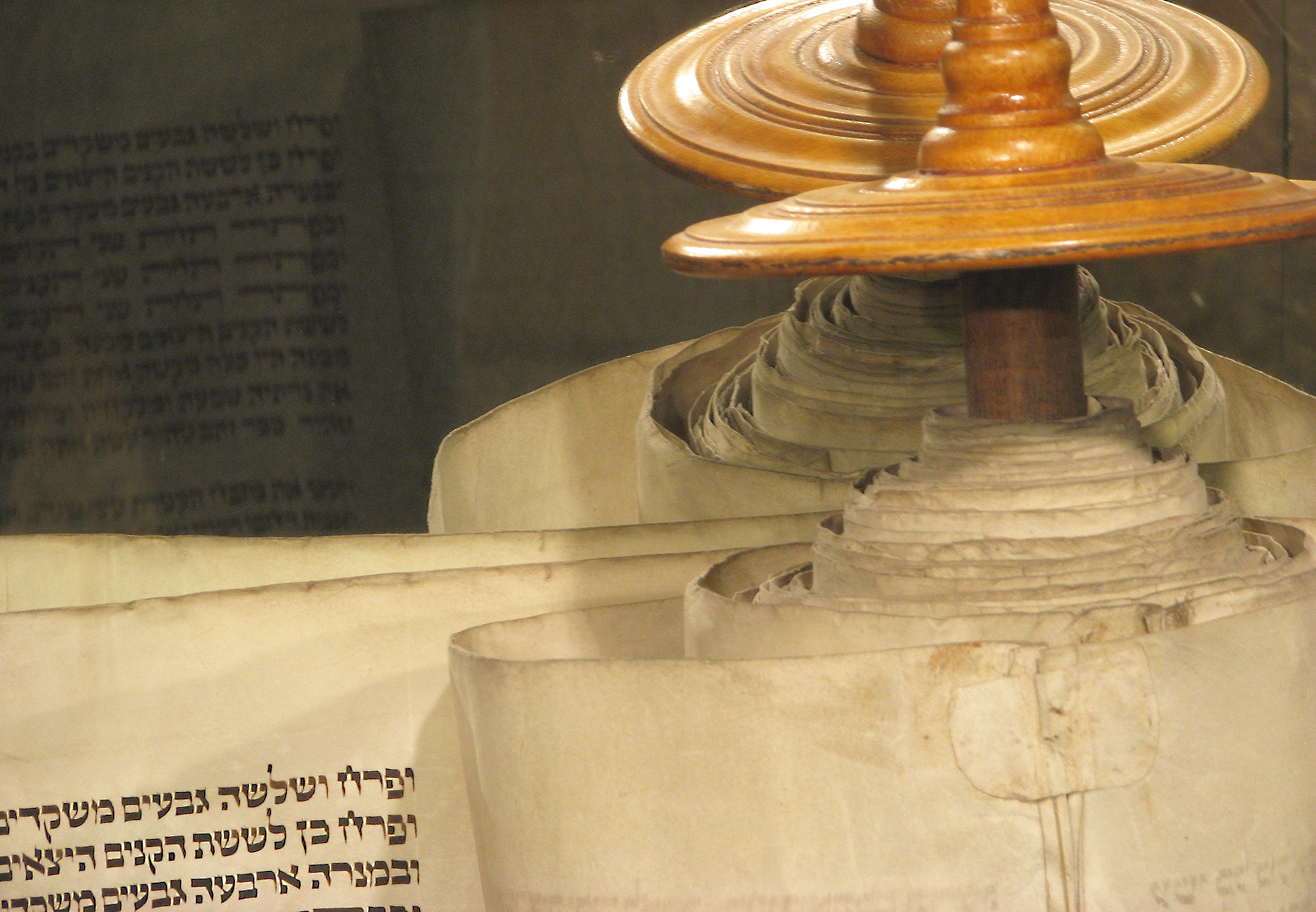
Bible, History, Archaeology
Bible,
History,
Archaeology
La massore,
the Massoretes
The massore comprises all the information concerning the Sacred Text, long preserved by oral tradition.
Introduction
Copies of biblical texts have come down to us thanks to copyists whose job it was to reproduce the sacred texts as accurately as possible.

- The Sopherim of Ezra (5th - 2nd century BC)
- The Zugoth (2nd - 1st century BC)
- The Tannaim (until the 3rd century CE).
- The Talmudists (1st - 5th centuries CE).
- The Massorets (5th-11th centuries CE) with two schools: the School of Tiberias (and the Ben Asher family) and the School of Babylonia.
Image opposite: a Torah scroll. © DR.
The Massorets were Jewish scholars who fixed the reading of the alphabet and texts. They literally «saved» Hebrew, making it possible to read Old Testament texts in their original language today. They invented the vowel dot, because up until the 5th century CE, Hebrew text consisted entirely of consonants.. The tradition handed down by the forefathers was enough to ensure a normal reading, but as the Jewish people assimilated with foreign nations, the exact phonetic pronunciation of words was increasingly compromised. Dot-vowels were only finally developed around the 9th century CE.
They also invented a system of accents and a way of joining or separating words.
Working methods

- Comparison of Hebrew manuscripts, by consulting the passages contained in 1,500 to 2,000 manuscripts.
To copy the text :
- They copied the text with extraordinary care. According to some writers, the error of a single letter rendered the manuscript unusable.
- They annotated the text to prevent any additions or omissions. They counted how many times each letter appears in Scripture. Thus the letter aleph 42,377 times, the letter beth 38,218 times, etc. The total number of letters in the Old Testament is 815,280. The purpose of this calculation was to prevent the addition or omission of a single letter. They found 23,206 verses in the Old Testament. They indicate the middle letter in each book or collection of books (e.g. for the Pentateuch, the middle letter is in the word belly, Leviticus 11:42). They also count the verses, words and letters in each section.
- They invented vowel points, a system of accents and a way of joining or separating words (see above).
Image opposite: a Yemeni scribe studying a Torah scroll in the early 20th century. Library of Congress, EU.
It should be emphasized that this annotated text is considered profane and cannot be used in synagogues, where only the handwritten Bible is read, in the form of scrolls, as in the past, without any vowels or accents. Although the rabbis had long opposed the introduction of vocal signs into the text, the need to fix pronunciation to prevent it from being lost forced the Jews to break with ancient tradition once the Talmud had been completed.
Here's an example of a difficulty encountered in translation:
In Joshua 9:4, we read in the Ostervald version:
«They (the Gabaonites) gave themselves up as ambassadors».
The Septuagint version reads: «took provisions».
The change of a single letter in the Hebrew text (vaïistaïâdou instead of vaïistaïârou) gives this meaning, which seems much more satisfactory, for why would the Gibeonites have given themselves as ambassadors, since they were indeed ambassadors and could not have been anything else? The Septuagint meaning is supported by verse 12: «This is the bread... with which we have made provision».
This translation was adopted by Louis Segond.
the oldest manuscripts in our possession
In 1896, in the Gueniza of the Ben Ezra de Fostat Karaite synagogue in Old Cairo, a unique batch of manuscripts (around 200,000!) was discovered.) These include liturgical poems, private writings and, above all, thousands of fragments of biblical books in Hebrew and Aramaic, as well as Arabic translations, most of which date from the 8th to 14th centuries AD.
The significance of this discovery almost rivals that made near the site of Khirbet Qumran, near the Dead Sea, by some sixty years.
These manuscripts were deposited in major libraries in Russia (St. Petersburg), the United States and especially England (Cambridge, Oxford and London).
Examination of all these pieces is proving most fruitful for the history of the transmission of the text of Scripture. We are now in a position to reconstruct the stages of its vocalization (of the «massore»): many fragments of Gueniza are witness to long attempts at Babylonian or Palestinian vocalization.

